SILVANA MOSSANO
Reportage dell’udienza di lunedì 13 dicembre 2021
I 392 casalesi e monferrini che si sono ammalati di mesotelioma sono morti in anticipo di sette/otto anni rispetto alle persone che, per altre cause, sono morte in Piemonte tra il 1980 e il 2015. L’età media del decesso nelle 392 vittime indicate nel processo Eternit Bis, in cui Stephan Schmidheiny risponde di omicidio volontario con dolo eventuale, è, infatti, pari a 69,6 anni; quella dei piemontesi morti per altre cause è stata di 77,8 anni. L’esposizione all’amianto, che provoca il mesotelioma, ha quindi anticipato la morte di tutti quegli uomini e donne: operai e operaie dell’Eternit, loro famigliari o cittadini che hanno vissuto lì, quando l’aria era infettata dalla diffusione incontrollata di fibre che si sapevano cancerogene fin dalla metà del secolo scorso.
«Il 90% delle morti di mesotelioma non si sarebbe verificato senza l’esposizione all’amianto» ha ribadito il professor Corrado Magnani, consulente della procura, al controesame da parte della difesa che si è svolto lunedì 13 dicembre. Con lui, si è sottoposto a controesame il dottor Dario Mirabelli, entrambi epidemiologi.
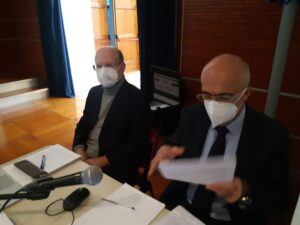
Morti anticipate di anni, dunque. «Quanti anni? Troppi troppi troppi. Tutti sottratti alla vita, all’amore, alla comunità» ha postato su Facebook, in uno slancio incontenibile di dolore e di indignazione, Assunta Prato, una delle vedove dell’amianto, parte civile al processo.
LA DIFESA ALL’ATTACCO
Ma i difensori, Astolfo Di Amato e Guido Carlo Alleva, tirano fuori gli artigli per demolire l’impianto dell’accusa, sostenuto dai pm Gianfranco Colace e Mariagiovana Compare. La prima e principale trincea da cui muovere l’attacco è quella contro una serie di argomenti importanti sollevati dai consulenti del pm. E’ il terreno su cui si deciderà il processo. Tanto importante che, lunedì, era presente nell’aula d’Assise anche uno dei legali svizzeri dell’imputato, per osservare in presenza lo svolgimento di queste fasi cruciali del dibattimento.
IN DISCUSSIONE I SINGOLI CASI
La prima parte dell’udienza è stata dedicata al controesame dei consulenti Massimiliano Bugiani e Pavilio Piccioni, pneumologi, Ferruccio Perrelli, medico del lavoro (già ascoltati nell’udienza del 15 novembre).
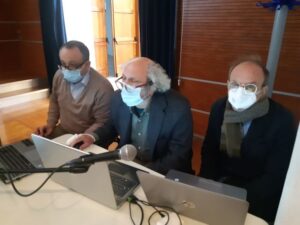
Se ne è occupato l’avvocato Di Amato, mettendo in discussione, con cura minuziosa, i singoli casi, per ognuno dei quali gli esperti dei pm avevano compilato una scheda con nome, cognome e storia personale: dove ha abitato e con chi, dove ha lavorato e per quanto tempo, quando si è ammalato ed è morto. Le contestazioni del legale si sono concentrate sulle conclusioni dei consulenti in merito alle fonti di esposizione all’amianto che hanno causato il mesotelioma. Soprattutto è stato contestato il ruolo delle cosiddette «esposizioni ambientali», determinate dall’aver abitato nel territorio in cui per 80 anni, dal 1907 al 1986, è stata attiva l’Eternit, con lo stabilimento di via Oggero al Ronzone, i magazzini di stoccaggio in piazza d’Armi, l’attività di scarico della materia prima alla stazione ferroviaria, la discarica vicino a Po, l’andirivieni dei camion per le strade tra le case, anche a ridosso del centro.
QUANTO INCIDE L’ESPOSIZIONE AMBIENTALE?
Di Amato domanda, incalza, pacato quanto pignolo: «Come fate a dire che l’esposizione ambientale ha avuto un ruolo rilevante ai fini dell’insorgenza del mesotelioma in una specifica persona – ha più volte insistito il legale, citando caso dopo caso –, di cui è documentata anche una importante esposizione famigliare (genitori o altri conviventi che sono stati operai all’Eternit, ndr) o professionale (ha lavorato in ferrovia, o nel settore edile, meccanico, del freddo, o in oreficeria dove c’era amianto se pur non come materia prima, oppure ha usato ferri da stiro industriali o phon nei quali Di Amato ha sostenuto fosse presente amianto, ndr)?». Il difensore ha altresì evidenziato che, in alcuni casi di malati che erano stati esposti professionalmente al di fuori dell’Eternit, l’Inail aveva riconosciuto la malattia professionale. E, dunque, che incide l’esposizione ambientale? E, poi, soprattutto: quando la persona colpita da mesotelioma avrebbe respirato la fibra da cui si è generato il tumore?
IL MOMENTO DELL’«INDUZIONE»
Uno dei punti chiave è proprio quello temporale: la procura deve dimostrare (con l’apporto delle parti civili) che le fibre che hanno provocato i 392 mesoteliomi sono stata diffuse dolosamente nel cosiddetto «periodo di garanzia» su cui il procedimento giudiziario in Corte d’Assise si concentra: cioè tra il 1976 e il 1986, quando l’imprenditore Stephan Schmidheiny ha gestito direttamente l’Eternit italiana. In realtà, testimonianze e documenti attestano che l’imputato già si occupava dell’azienda famigliare dell’amianto fin dal 1973, ma il capo, formalmente, era ancora il padre Max: lasciò, poi, il settore del cemento al figlio Thomas e quello dell’amianto a Stephan, a partire appunto dal 1976.
Va peraltro annotato, per completezza, che le transazioni economiche con alcuni dei famigliari delle vittime coprono il periodo di esposizione che va dal 1973 (e non 1976) fino al 1988: la fabbrica di Casale nel 1986 fu sì chiusa, ma, piena di amianto sparso, fu abbandonata così com’era. La somma viene offerta, secondo la definizione dei legali di Schmidheiny, non a titolo risarcitorio, ma come gesto filantropico ai cittadini (o loro eredi) che si sono ammalati; attualmente è pari a 30 mila euro. Fino al 2015, per ogni transazione era previsto un contestuale accantonamento di 20 mila euro destinato alla ricerca scientifica, poi sospeso.
IL PERIODO DI GARANZIA NEL PROCESSO
Comunque, nel processo Eternit Bis il periodo di cui è chiamato a rispondere Stephan Schmiheiny è compreso tra il 1976 e il 1986. L’avvocato Di Amato ha tenuto pertanto a ricordare che, già dal 1974, il ciclo produttivo era passato da secco a umido, con un oggettivo abbattimento delle polveri. E così, secondo logica, anche l’ambiente esterno alla fabbrica sarebbe stato meno contaminato.
E’ vero? Beh, le verifiche dell’Ispettorato del lavoro tra il 1976 e il 1978 evidenziarono numerose perdite di polvere dagli impianti, la mancanza di sistemi di aspirazione localizzata e tanta polvere ovunque nella fabbrica. Lo stesso Centro Amiantus svizzero aveva svolto un controllo interno nel 1980 e aveva riscontrato una situazione problematica. Per arrivare al 1983, quando Michele Salvini, il perito nominato dal giudice del lavoro di Casale, aveva trovato molta polvere depositata sulle parti più alte dei macchinari e degli impianti (il famoso sopralluogo con la scaletta!).
Inoltre, va rammentato che i «ventoloni», raffigurati in varie fotografie prodotte al dibattimento, hanno continuato a «sparare» aria contaminata, non filtrata, fuori dallo stabilimento. E, ancora: nel reparto Petralit, dove si preparavano pezzi su misura a richiesta dei committenti, le lastre erano manipolate con seghe e altri attrezzi sfarinando polvere. Soprattutto è ampiamente documentato che, nell’area ex Piemontese, esterna allo stabilimento e collocata a un centinaio di metri di distanza, con una pala meccanica si frantumavano scarti a cielo aperto, con cospicua diffusione delle fibre nella città. La frantumazione era funzionale all’attività del mulino Hazemag, installato in fabbrica proprio nel periodo di gestione di Stephan Schmidheiny: gli scarti sminuzzati venivano così reimmessi, in una certa percentuale, nell’impasto di produzione. Questa attività era sistematica visto che gli scarti non erano soltanto quelli di Casale, ma arrivavano anche dagli stabilimenti di Bagnoli, Rubiera e Siracusa. E nell’area aperta tra le case dell’ex Piemontese l’unico «umido» era garantito, a-dio-piacendo, quando occasionalmente pioveva.
TUTTE LE ESPOSIZIONI CONCORRONO AL RISCHIO DI AMMALARSI
Il difensore Di Amato sul peso dell’esposizione ambientale, dovuta alla residenza a Casale o in un raggio di pochi chilometri dalla città, ha preteso spiegazioni e chiarimenti, peraltro legittimi tanto più vista la gravità del reato contestato. Le risposte dei 3 consulenti del pm, caso per caso, si possono riassumere così: hanno tenuto in considerazione tutte le fonti di esposizione, famigliare o professionale in ambiti anche diversi da Eternit, ma questo non esclude la rilevanza, contemporanea o successiva, dell’esposizione ambientale; ogni esposizione ha giocato un proprio ruolo sul nesso causale con le patologie insorte; più sono le esposizioni, più si riduce l’efficacia delle difese messe in atto dal nostro sistema immunitario. E ancora: «Così come sappiamo che anche dosi basse di esposizione possono ingenerare il mesotelioma, allo stesso modo sappiamo che più è intensa e prolungata l’esposizione più aumenta la probabilità che si manifesti il tumore».
TUTTI QUEI TETTI DI ONDULINE
E i tetti? Che incidenza hanno avuto le coperture di lastre d’amianto sui capannoni, sugli edifici pubblici e privati, sui pollai? Coperture che, fino alla legge del 1992, era legale produrre e installare. «Se le coperture sono in stato conservativo buono – hanno risposto gli esperti – incidono minimamente sull’inquinamento dell’atmosfera con fibre di amianto. Quando, invece, cominciano a deteriorarsi, generano un rischio che può concorrere all’insorgenza della malattia». E’ per questo che si deve bonificare, e il territorio di Casale è di certo quello che ha bonificato di più al mondo.
I tetti di «eternit» erano (e sono ancora) diffusi ovunque, non solo nei luoghi dove si producevano. Però l’incidenza di mesoteliomi è ben più alta a Casale (e Broni, Bari, ad esempio, dove c’erano stabilimenti Eternit e Fibronit) rispetto ad altre città dove la fonte quasi esclusiva di diffusione della fibra è rappresentata dai tetti.
CONTESTATA LA «DOSE CUMULATIVA»
Ma più di tutto i numeri di malattie e morti raccontano la luttuosa realtà.
Gli epidemiologi Magnani e Mirabelli hanno ribadito alcuni dei dati sugli studi già illustrati ampiamente nell’udienza del 29 novembre, rispondendo, in modo misurato e imperturbabile, al pressante fuoco di fila dell’avvocato Alleva, ansioso di controbattere le tesi dei consulenti dei pm anche stoppando aspramente le loro spiegazioni quando confutavano le argomentazioni difensive.
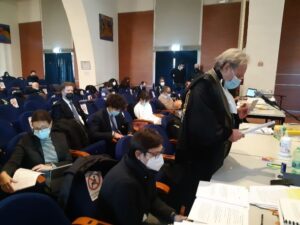
L’avvocato Alleva ha contestato il fatto che la cosiddetta «dose cumulativa» di esposizione sia determinante a causare il rischio di mesotelioma: a parere della difesa, e dei suoi consulenti, tra cui Canzio Romano, presente alle udienze, l’«induzione» del mesotelioma (la fase compresa tra l’esposizione all’amianto e il momento in cui si ammala la prima cellula nell’organismo) avviene entro un periodo molto breve dopo l’inizio dell’esposizione: le esposizioni successive non hanno più effetto, perché ormai il tumore c’è già, benché non ancora visibile e diagnosticabile. Gli studi degli epidemiologi mostrano, al contrario, che il rischio cambia di molto in base alla dose cumulativa, che tiene conto, cioè, di tutte le esposizioni: sia le prime che quelle successive.
I difensori hanno incalzato con altre domande: se non si può individuare con precisione quel tempo, come si può attribuire la penale responsabilità di quella morte a un determinato imputato (in questo caso Stephan Schmidheiny)? E’ possibile stabilire il momento preciso in cui una determinata esposizione ha modificato la prima cellula che, moltiplicandosi, diventerà tumore visibile a distanza di anni?
IL NOTEVOLE ECCESSO DI RISCHIO
Le risposte degli epidemiologi risiedono nei loro studi – decine – pubblicati su riviste autorevoli e ritenuti validi dalla comunità scientifica internazionale.
Ad esempio, l’analisi sulla coorte dei lavoratori Eternit maschi ha evidenziato il rischio di ammalarsi di mesotelioma 30 volte maggiore rispetto a un maschio piemontese non esposto professionalmente. In altre parole, se la frequenza del mesotelioma fosse stata uguale a quella degli abitanti del Piemonte ci sarebbe stato un solo caso e non i 30 che si sono verificati nella coorte: 29 di quei 30 (cioè il 96,6%) sono semplicemente di troppo. Dall’analisi delle operaie dell’Eternit emerge un eccesso di donne ammalate pari al 98%.
E nella popolazione in generale? Lo studio che analizza l’andamento tra il 2010 e il 2014 registra un eccesso di mesoteliomi pari al 92% rispetto alla popolazione piemontese.
«Ma questi sono dati epidemiologici e non riferiti al singolo caso» ha replicato il legale Alleva. Sì, certo, è stata la risposta dei consulenti della procura: poiché l’osservazione individuale non è possibile, in medicina si ricorre all’epidemiologia, basata sul confronto tra due popolazioni, una esposta e una non esposta. Si possono creare anche dei sottogruppi omogenei (uomini, donne, anziani, giovani), ma si tratta sempre di gruppi messi a confronto. Da qui emerge, in base ai risultati illustrati da Magnani e Mirabelli, che, appunto, senza quella esposizione all’amianto oltre il 90 per cento delle persone esaminate non sarebbero morte di mesotelioma. Anzi, il mesotelioma sarebbe quasi assente a Casale se non ci fosse stata l’Eternit.
PROSSIMA UDIENZA
Lunedì 20 dicembre, saranno esaminati la professoressa Irma Dianzani, genetista, consulente della procura, e il professor Edoardo Bai, epidemiologo, consulente di parte civile per Medicina Democratica.
Nell’immagine in apertura, avvocati difensori e di parte civile, pubblici ministeri e consulenti delle parti (in primo piano, Canzio Romano, ctp della difesa)
Traduzione di Vicky Franzinetti
Translation by Vicky Franzinetti
December the 13th , 2021 Eternit Hearing
Without the Eternit Plant there we wouldn’t have had all those mesotheliomas in Casale
by Silvana Mossano
The 392 people from Casale and Monferrato who developed mesothelioma died seven to eight years earlier than the people who died in Piedmont between 1980 and 2015 due to other causes. The average age of death of the 392 victims named in the Eternit Bis trial where Stephan Schmidheiny is accused of murder was 69.6 years while the average age in Piedmont for death from other causes was 77.8 years. Exposure to asbestos, which causes mesothelioma, bringing forward the death of all those men and women: workers and Eternit workers, their families or members of the community, who breathed in the airborne fibres known to be carcinogenic since the middle of the last century.
“Ninety percent of mesothelioma deaths would not have occurred without exposure to asbestos,” stated Professor Corrado Magnani, an expert witness for the Prosecution, when cross-examined by the defence on Monday, December 13. The other epidemiologist expert witness Dr. Dario Mirabelli, was also cross-examined. Early deaths of years. “How many years [did they lose]? Too many too many. All robbed from life, love, and community life” a plaintiff, Assunta Prato, one of the asbestos widows, posted on Facebook in an uncontrolled surge of pain and indignation.
THE DEFENSE ON THE ATTACK
Defence lawyers, Astolfo Di Amato and Guido Carlo Alleva, attacked in an attempt to demolish the Prosecution’s theory (PPs Dr Gianfranco Colace and Dr Mariagiovana Compare). The first and main line of attack referred to the key arguments raised by the Prosecution’s expert witnesses that will decide the outcome of the trial. This is why one of the defendant’s Swiss lawyers was also present on Monday in the Court of Assizes to observe these crucial moments of the trial in person.
INDIVIDUAL CASES
In the first part of the hearing, expert witnesses Doctors Massimiliano Bugiani and Pavilio Piccioni, pulmonologists, Dr Ferruccio Perrelli, occupational physician (already heard on November the 15th ) were cross-examined. Lawyer Di Amato questioned them in a detailed and meticulous manner on individual cases, referring to the card with name, surname and personal history that the experts had drawn up for each one: where the victims lived, who else was present in the household, where they worked and how long for, when they developed the illness, when did they die. Di Amato focused on the conclusions of the consultants regarding the sources of exposure to asbestos that caused the mesothelioma. Above all, the role of the so-called environmental exposures was questioned, that is having lived in the area where for 80 years, from 1907 to 1986, when Eternit was active, with the plant in Via Oggero al Ronzone, the storage warehouses in Piazza d’Armi, the unloading of raw materials at the railway station, the landfill near River Po, the coming and going of trucks in the streets between the houses, even close to the centre.
WHAT IS THE IMPACT OF ENVIRONMENTAL EXPOSURE?
A calm and meticulous Di Amato asked: “How can you say that environmental exposure played a significant role in the onset of mesothelioma in a specific person – he repeatedly insisted citing case after case -, when a major household exposure is also documented (relatives or other members of the household who were Eternit workers – Note) or when there is work related exposure (such as working in the railways, or in the construction industry, mechanical, fridge manufacturing, or goldsmiths where there was asbestos even if not as raw material, or if they used industrial irons or hair dryers where lawyer Di Amato claimed there was asbestos, Note)? “. Di Amato also pointed out that Inail, the national workers’ compensation agency, had recognized the occupational disease to workers who had been exposed to asbestos for work outside Eternit. So, what is the effect of environmental exposure? And, above all: when did the person affected by mesothelioma breath the fibre which caused the tumour?
INDUCTION: WHEN DID IT TAKE PLACE?
Time, the exact time of exposure is one of his key arguments: the defence maintains the Prosecution (with the help of plaintiffs) must prove that the fibres that caused the 392 mesotheliomas were intentionally circulated in the so-called “period”- (known as periodo di garanzia) ” which the current proceedings in the Court of Assizes is dealing with, that is, between 1976 and 1986, when the entrepreneur Stephan Schmidheiny directly managed the Italian Eternit. Witnesses and documents prove that the defendant had already been dealing with the family asbestos business since 1973, but formally, the head, was still his father Max who left the cement business to his son Thomas and the asbestos to Stephan, starting from 1976”. The economic transactions with victims’ families cover the period of exposure from 1973 (not 1976) to 1988: the factory in Casale was closed in 1986, but it was abandoned without any remedial action, full of asbestos that then flew all over the town. According to Schmidheiny’s attorneys, the sum was not offered as compensation, but as a philanthropic gesture in favour of members of the community who had developed an illness. Compensation amounted to 30 thousand Euros. A corresponding 20 thousand Euros was paid into scientific research but that provision was discontinued after 2015.
THE PERIOD COVERED BY THE TRIAL
In the Eternit Bis trial Stephan Schmiheiny is called to answer for 1976-1986. Lawyer Di Amato recalled that, from 1974, the production cycle had switched from dry to wet, to reduce dust. Logically contamination outside the factory should have also dropped. Did it happen? Inspections carried out by the Labour Inspectorate between 1976 and 1978 revealed numerous dust leaks from the plants, a lack of localized suction systems and a lot of dust everywhere in the factory. The Swiss Amiantus Centre itself had carried out an internal audit in 1980 and found a difficult situation. In 1983, Dr Michele Salvini, the expert appointed by the Industrial Court of Casale, found a lot of dust deposited on the highest parts of the machines and plants (the famous inspection with the ladder!). Moreover, as seen in photographs produced at the hearings, the “fans” continued to spew contaminated, unfiltered air outside. In the Petralit workshop, where custom-made pieces were manufactured, A-C sheets were handled with saws and other tools, generating dust. Above all, in the ex-Piemontese area, outside the plant located about a hundred metres away, a mechanical shovel was used to crush waste in the open air, with considerable dispersion of fibres throughout the town. Crushing was functional to the Hazemag mill, installed in the factory during the period of Stephan Schmidheiny’s management: a percentage of the shredded waste was re-used in the production mix. It was an ongoing activity using waste from the plants in Bagnoli, Rubiera and Siracuse and not just from the Casale plant. In the open-air area among the houses aka ex-Piemontese, the only wet process took place when it rained.
ALL EXPOSURES CONTRIBUTE TO THE DEVELOPMENT OF THE DISEASE
Defence lawyer Di Amato demanded explanations and clarifications in view of the environmental exposure when living in Casale or in a radius of a few kilometres from the town, the more so given the seriousness of the accusation. The answers of the three PP’s expert witnesses can be summarized as follows: they took all sources of exposure, household or professional (work related) into account in areas other than Eternit, but this does not exclude the role of environmental exposure at the time or later. Each exposure played its own role in causing the onset of the disease. The more exposures, the less our immune system can cope with them. And again: “Just as we know that even low doses of exposure can lead to mesothelioma, we also know that more intense and prolonged exposure increases the likelihood of cancer occurring”.
ALL THOSE CORRUGATED ROOFS
What about the roofs? What was the incidence of asbestos sheet roofing on warehouses, on public and private buildings, on chicken coops? Roofing that was legal to manufacture and install until the 1992 legal ban. “If the roofs are in a good state of preservation – the experts replied – they cause extremely limited airborne asbestos fibre pollution. Instead, when they begin to deteriorate and fray, they generate a risk that can contribute to the onset of disease.” This is why an overall reclamation is required, and the area of Casale has carried out one of largest in the world. Eternit roofs were (and still are) everywhere, not only where they were produced. However, the incidence of mesothelioma is much higher in Casale (and Broni or Bari, for example, where there were Eternit and Fibronit plants were) than in other cities where rooftops are the almost exclusive source of fibres.
“CUMULATIVE DOSE” QUESTIONED
More than anything else, the numbers of cases and deaths speak to the grim picture. Epidemiologists Magnani and Mirabelli repeated some of the data from the studies that had been illustrated at length in the November the 29th hearing, answering the pressing barrage of lawyer Alleva’s questions in a measured and unflappable manner, as the defence lawyer was anxious to refute the PP’s expert witnesses interpretation and even sharply interrupted their explanations when they refuted his arguments. Lawyer Alleva questioned the fact that the “cumulative dose” of exposure plays a key role in the risk of mesothelioma: in the opinion of the defence, and its consultants, including Prof Canzio Romano, who was present at the hearings, the “induction” of mesothelioma (that is the time elapsing between exposure to asbestos and when the first cell in the body becomes ill) occurs within a very short period after initial exposure: subsequent exposures no longer have an effect, because by now the tumour is already there, although not yet visible and diagnosable. On the contrary, epidemiological studies show that risk varies substantially according to the cumulative dose that takes all exposures into account: both the early and later ones. The defence pressed with other questions: if it is not possible to identify precisely that time, how can the defendant (in this case Stephan Schmidheiny) be held criminally responsibility for a specific death? And again: is it possible to establish the precise moment when a given exposure modified the first cell that, by multiplying, was to become a tumour visible years later?
THE SIGNIFICANT EXCESS OF RISK
The answers of the epidemiologists are in their studies – dozens of them – published in authoritative journals and confirmed by the international scientific community. For example, the study of male Eternit workers cohort showed that the risk of developing mesothelioma was 30 times greater than that of a male Piedmontese (of an equivalent cohort) with no work exposure. In other words, if the frequency of mesothelioma had been the same as that of the non exposed Piedmontese males, there would have been only one case and not the thirty that occurred in the workers’ cohort: 29 of those 30 (i.e., 96.6%) are simply in excess. The analysis of the female Eternit workers shows an excess of 98%. And what about the general population? The study of data between 2010 and 2014 shows an excess of mesotheliomas equal to 92% compared to the overall population of Piedmont. “But these are epidemiological data and not referred to the individual case,” replied defence Lawyer Alleva. Yes, true, was the PP’s consultants’ answer: since individual observation is not possible, in medicine we resort to epidemiology, based on the comparison between two populations, one exposed and the other not exposed. One can also create homogeneous subgroups (men, women, elderly, young people), but they are always groups for comparison. Hence, on the basis of the results illustrated by Magnani and Mirabelli, without that exposure to asbestos over 90% of the people examined would not have died of mesothelioma. In fact, had there been no Eternit plant, there would have hardly been any mesothelioma, if any, in Casale.
NEXT HEARING
On Monday, December the 20th , Professor Irma Dianzani, geneticist, expert witness for the Prosecution and Professor Edoardo Bai, epidemiologist, expert witness for the Association Medicina Democratica (also a plaintiff in the case) will be heard.

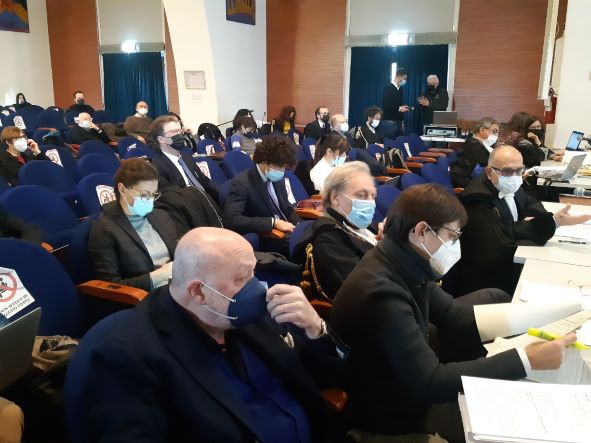
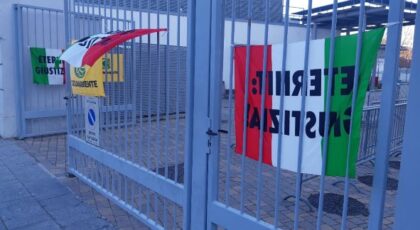
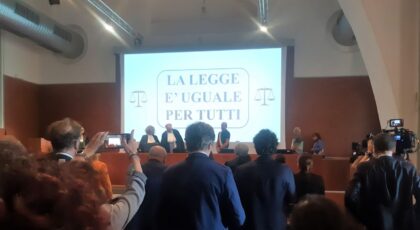

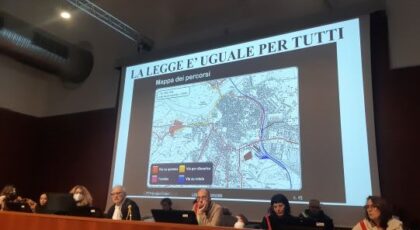
Grazie Silvana, ottimo resoconto, ottime puntualizzazioni che riportano alla realtà dei fatti che hanno causato l’enorme tragedia.
B P
Preziosa Silvana che documenti con dovizia di particolari tutte le fasi del processo . A leggere ciò che scrivi mi viene la pelle d’oca , soprattutto se penso che io ho abitato vicino al magazzino di stoccaggio di piazza d’Armi e da bambina ho giocato con i miei amici tra i grossi tubi di amianto . E purtroppo molti amici se ne sono già andati proprio colpiti da questo male atroce . Non molliamo .
Grazie Silvana. Sempre puntuale e precisa . Stai praticamente scrivendo un “nuovo “‘libro ! Brava
Grazie per le dettagliate informazioni.
Viviamo in uno stato di diritto, dove le garanzie sono garanzie per tutti noi, quindi è giusto che l’imputato abbia degli avvocati difensori. Ma che sofferenza ascoltare parole che negano l’evidenza!
La giustizia può esserci soltanto a partire dal riconoscimento delle responsabilità.
Per noi è lampante la responsabilità dell’imputato. Per noi e per più di 3000 morti. Come è possibile metterlo in discussione?